International Business Communications: Margot Bakery in India
VerifiedAdded on 2023/06/06
|11
|3527
|490
AI Summary
This report analyzes the international business communication strategies for Margot Bakery in India. It covers the country's overview, cultural sensitivity, communication barriers, and appropriate communication strategies for success.
Contribute Materials
Your contribution can guide someone’s learning journey. Share your
documents today.

PROJECT 1
Secure Best Marks with AI Grader
Need help grading? Try our AI Grader for instant feedback on your assignments.
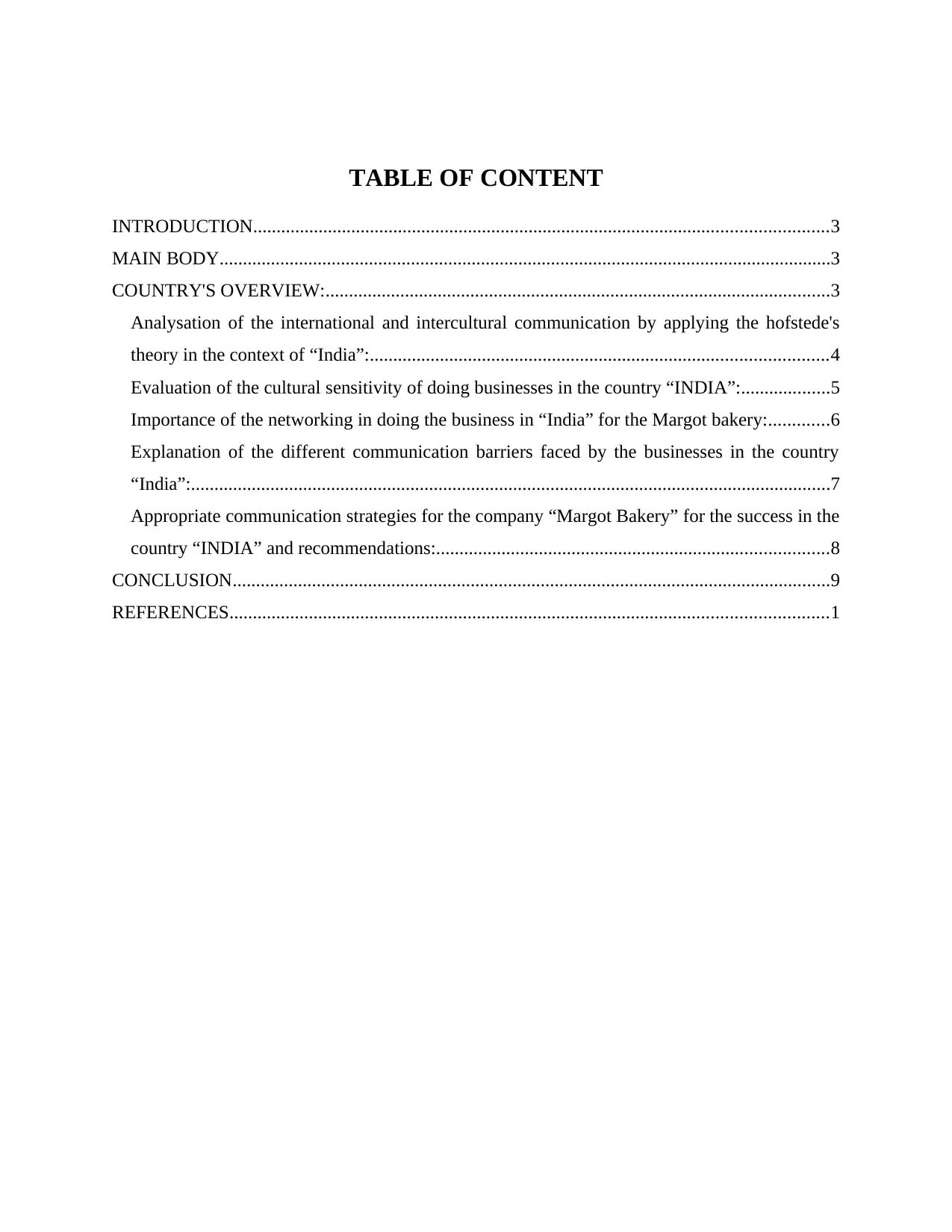
TABLE OF CONTENT
INTRODUCTION...........................................................................................................................3
MAIN BODY...................................................................................................................................3
COUNTRY'S OVERVIEW:............................................................................................................3
Analysation of the international and intercultural communication by applying the hofstede's
theory in the context of “India”:..................................................................................................4
Evaluation of the cultural sensitivity of doing businesses in the country “INDIA”:...................5
Importance of the networking in doing the business in “India” for the Margot bakery:.............6
Explanation of the different communication barriers faced by the businesses in the country
“India”:.........................................................................................................................................7
Appropriate communication strategies for the company “Margot Bakery” for the success in the
country “INDIA” and recommendations:....................................................................................8
CONCLUSION................................................................................................................................9
REFERENCES................................................................................................................................1
INTRODUCTION...........................................................................................................................3
MAIN BODY...................................................................................................................................3
COUNTRY'S OVERVIEW:............................................................................................................3
Analysation of the international and intercultural communication by applying the hofstede's
theory in the context of “India”:..................................................................................................4
Evaluation of the cultural sensitivity of doing businesses in the country “INDIA”:...................5
Importance of the networking in doing the business in “India” for the Margot bakery:.............6
Explanation of the different communication barriers faced by the businesses in the country
“India”:.........................................................................................................................................7
Appropriate communication strategies for the company “Margot Bakery” for the success in the
country “INDIA” and recommendations:....................................................................................8
CONCLUSION................................................................................................................................9
REFERENCES................................................................................................................................1
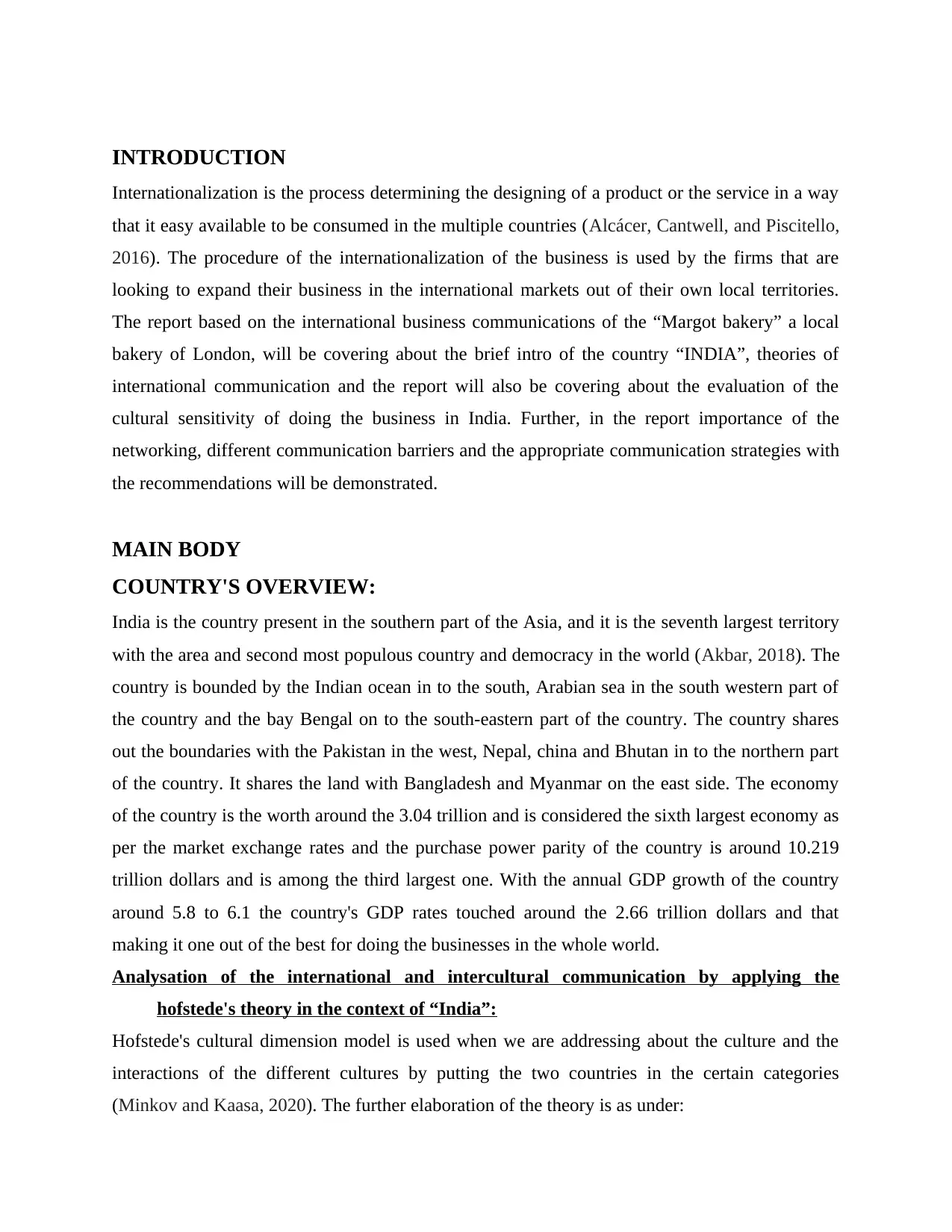
INTRODUCTION
Internationalization is the process determining the designing of a product or the service in a way
that it easy available to be consumed in the multiple countries (Alcácer, Cantwell, and Piscitello,
2016). The procedure of the internationalization of the business is used by the firms that are
looking to expand their business in the international markets out of their own local territories.
The report based on the international business communications of the “Margot bakery” a local
bakery of London, will be covering about the brief intro of the country “INDIA”, theories of
international communication and the report will also be covering about the evaluation of the
cultural sensitivity of doing the business in India. Further, in the report importance of the
networking, different communication barriers and the appropriate communication strategies with
the recommendations will be demonstrated.
MAIN BODY
COUNTRY'S OVERVIEW:
India is the country present in the southern part of the Asia, and it is the seventh largest territory
with the area and second most populous country and democracy in the world (Akbar, 2018). The
country is bounded by the Indian ocean in to the south, Arabian sea in the south western part of
the country and the bay Bengal on to the south-eastern part of the country. The country shares
out the boundaries with the Pakistan in the west, Nepal, china and Bhutan in to the northern part
of the country. It shares the land with Bangladesh and Myanmar on the east side. The economy
of the country is the worth around the 3.04 trillion and is considered the sixth largest economy as
per the market exchange rates and the purchase power parity of the country is around 10.219
trillion dollars and is among the third largest one. With the annual GDP growth of the country
around 5.8 to 6.1 the country's GDP rates touched around the 2.66 trillion dollars and that
making it one out of the best for doing the businesses in the whole world.
Analysation of the international and intercultural communication by applying the
hofstede's theory in the context of “India”:
Hofstede's cultural dimension model is used when we are addressing about the culture and the
interactions of the different cultures by putting the two countries in the certain categories
(Minkov and Kaasa, 2020). The further elaboration of the theory is as under:
Internationalization is the process determining the designing of a product or the service in a way
that it easy available to be consumed in the multiple countries (Alcácer, Cantwell, and Piscitello,
2016). The procedure of the internationalization of the business is used by the firms that are
looking to expand their business in the international markets out of their own local territories.
The report based on the international business communications of the “Margot bakery” a local
bakery of London, will be covering about the brief intro of the country “INDIA”, theories of
international communication and the report will also be covering about the evaluation of the
cultural sensitivity of doing the business in India. Further, in the report importance of the
networking, different communication barriers and the appropriate communication strategies with
the recommendations will be demonstrated.
MAIN BODY
COUNTRY'S OVERVIEW:
India is the country present in the southern part of the Asia, and it is the seventh largest territory
with the area and second most populous country and democracy in the world (Akbar, 2018). The
country is bounded by the Indian ocean in to the south, Arabian sea in the south western part of
the country and the bay Bengal on to the south-eastern part of the country. The country shares
out the boundaries with the Pakistan in the west, Nepal, china and Bhutan in to the northern part
of the country. It shares the land with Bangladesh and Myanmar on the east side. The economy
of the country is the worth around the 3.04 trillion and is considered the sixth largest economy as
per the market exchange rates and the purchase power parity of the country is around 10.219
trillion dollars and is among the third largest one. With the annual GDP growth of the country
around 5.8 to 6.1 the country's GDP rates touched around the 2.66 trillion dollars and that
making it one out of the best for doing the businesses in the whole world.
Analysation of the international and intercultural communication by applying the
hofstede's theory in the context of “India”:
Hofstede's cultural dimension model is used when we are addressing about the culture and the
interactions of the different cultures by putting the two countries in the certain categories
(Minkov and Kaasa, 2020). The further elaboration of the theory is as under:
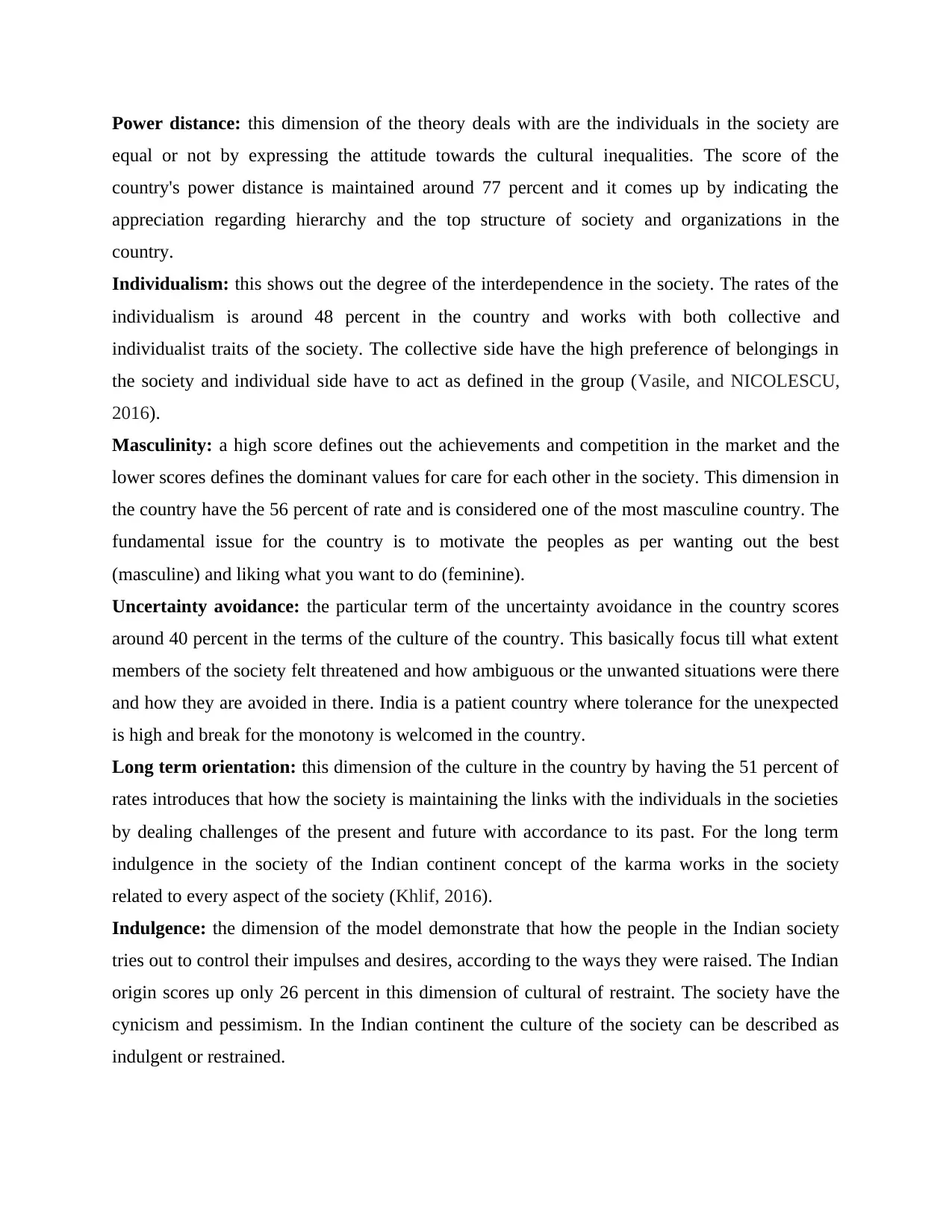
Power distance: this dimension of the theory deals with are the individuals in the society are
equal or not by expressing the attitude towards the cultural inequalities. The score of the
country's power distance is maintained around 77 percent and it comes up by indicating the
appreciation regarding hierarchy and the top structure of society and organizations in the
country.
Individualism: this shows out the degree of the interdependence in the society. The rates of the
individualism is around 48 percent in the country and works with both collective and
individualist traits of the society. The collective side have the high preference of belongings in
the society and individual side have to act as defined in the group (Vasile, and NICOLESCU,
2016).
Masculinity: a high score defines out the achievements and competition in the market and the
lower scores defines the dominant values for care for each other in the society. This dimension in
the country have the 56 percent of rate and is considered one of the most masculine country. The
fundamental issue for the country is to motivate the peoples as per wanting out the best
(masculine) and liking what you want to do (feminine).
Uncertainty avoidance: the particular term of the uncertainty avoidance in the country scores
around 40 percent in the terms of the culture of the country. This basically focus till what extent
members of the society felt threatened and how ambiguous or the unwanted situations were there
and how they are avoided in there. India is a patient country where tolerance for the unexpected
is high and break for the monotony is welcomed in the country.
Long term orientation: this dimension of the culture in the country by having the 51 percent of
rates introduces that how the society is maintaining the links with the individuals in the societies
by dealing challenges of the present and future with accordance to its past. For the long term
indulgence in the society of the Indian continent concept of the karma works in the society
related to every aspect of the society (Khlif, 2016).
Indulgence: the dimension of the model demonstrate that how the people in the Indian society
tries out to control their impulses and desires, according to the ways they were raised. The Indian
origin scores up only 26 percent in this dimension of cultural of restraint. The society have the
cynicism and pessimism. In the Indian continent the culture of the society can be described as
indulgent or restrained.
equal or not by expressing the attitude towards the cultural inequalities. The score of the
country's power distance is maintained around 77 percent and it comes up by indicating the
appreciation regarding hierarchy and the top structure of society and organizations in the
country.
Individualism: this shows out the degree of the interdependence in the society. The rates of the
individualism is around 48 percent in the country and works with both collective and
individualist traits of the society. The collective side have the high preference of belongings in
the society and individual side have to act as defined in the group (Vasile, and NICOLESCU,
2016).
Masculinity: a high score defines out the achievements and competition in the market and the
lower scores defines the dominant values for care for each other in the society. This dimension in
the country have the 56 percent of rate and is considered one of the most masculine country. The
fundamental issue for the country is to motivate the peoples as per wanting out the best
(masculine) and liking what you want to do (feminine).
Uncertainty avoidance: the particular term of the uncertainty avoidance in the country scores
around 40 percent in the terms of the culture of the country. This basically focus till what extent
members of the society felt threatened and how ambiguous or the unwanted situations were there
and how they are avoided in there. India is a patient country where tolerance for the unexpected
is high and break for the monotony is welcomed in the country.
Long term orientation: this dimension of the culture in the country by having the 51 percent of
rates introduces that how the society is maintaining the links with the individuals in the societies
by dealing challenges of the present and future with accordance to its past. For the long term
indulgence in the society of the Indian continent concept of the karma works in the society
related to every aspect of the society (Khlif, 2016).
Indulgence: the dimension of the model demonstrate that how the people in the Indian society
tries out to control their impulses and desires, according to the ways they were raised. The Indian
origin scores up only 26 percent in this dimension of cultural of restraint. The society have the
cynicism and pessimism. In the Indian continent the culture of the society can be described as
indulgent or restrained.
Secure Best Marks with AI Grader
Need help grading? Try our AI Grader for instant feedback on your assignments.
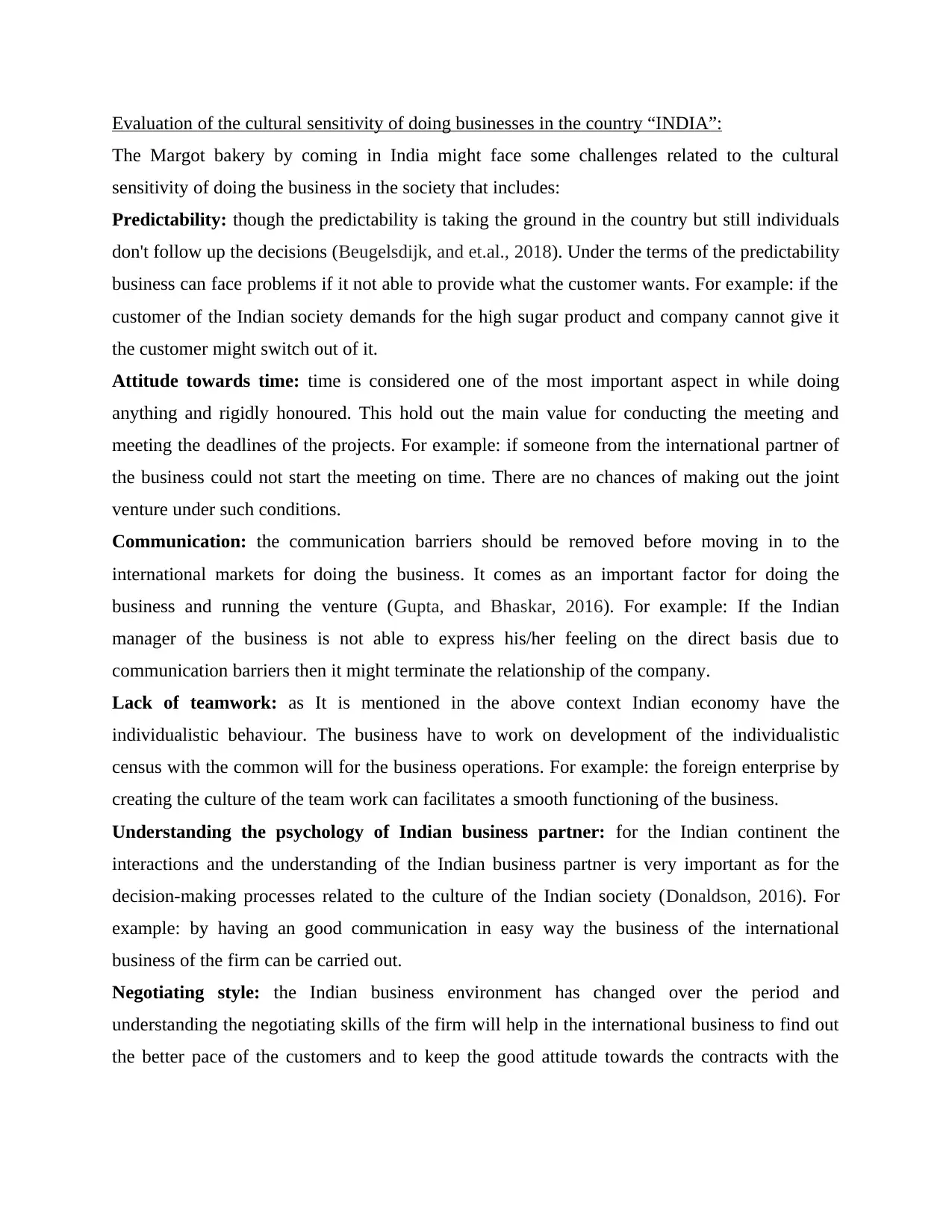
Evaluation of the cultural sensitivity of doing businesses in the country “INDIA”:
The Margot bakery by coming in India might face some challenges related to the cultural
sensitivity of doing the business in the society that includes:
Predictability: though the predictability is taking the ground in the country but still individuals
don't follow up the decisions (Beugelsdijk, and et.al., 2018). Under the terms of the predictability
business can face problems if it not able to provide what the customer wants. For example: if the
customer of the Indian society demands for the high sugar product and company cannot give it
the customer might switch out of it.
Attitude towards time: time is considered one of the most important aspect in while doing
anything and rigidly honoured. This hold out the main value for conducting the meeting and
meeting the deadlines of the projects. For example: if someone from the international partner of
the business could not start the meeting on time. There are no chances of making out the joint
venture under such conditions.
Communication: the communication barriers should be removed before moving in to the
international markets for doing the business. It comes as an important factor for doing the
business and running the venture (Gupta, and Bhaskar, 2016). For example: If the Indian
manager of the business is not able to express his/her feeling on the direct basis due to
communication barriers then it might terminate the relationship of the company.
Lack of teamwork: as It is mentioned in the above context Indian economy have the
individualistic behaviour. The business have to work on development of the individualistic
census with the common will for the business operations. For example: the foreign enterprise by
creating the culture of the team work can facilitates a smooth functioning of the business.
Understanding the psychology of Indian business partner: for the Indian continent the
interactions and the understanding of the Indian business partner is very important as for the
decision-making processes related to the culture of the Indian society (Donaldson, 2016). For
example: by having an good communication in easy way the business of the international
business of the firm can be carried out.
Negotiating style: the Indian business environment has changed over the period and
understanding the negotiating skills of the firm will help in the international business to find out
the better pace of the customers and to keep the good attitude towards the contracts with the
The Margot bakery by coming in India might face some challenges related to the cultural
sensitivity of doing the business in the society that includes:
Predictability: though the predictability is taking the ground in the country but still individuals
don't follow up the decisions (Beugelsdijk, and et.al., 2018). Under the terms of the predictability
business can face problems if it not able to provide what the customer wants. For example: if the
customer of the Indian society demands for the high sugar product and company cannot give it
the customer might switch out of it.
Attitude towards time: time is considered one of the most important aspect in while doing
anything and rigidly honoured. This hold out the main value for conducting the meeting and
meeting the deadlines of the projects. For example: if someone from the international partner of
the business could not start the meeting on time. There are no chances of making out the joint
venture under such conditions.
Communication: the communication barriers should be removed before moving in to the
international markets for doing the business. It comes as an important factor for doing the
business and running the venture (Gupta, and Bhaskar, 2016). For example: If the Indian
manager of the business is not able to express his/her feeling on the direct basis due to
communication barriers then it might terminate the relationship of the company.
Lack of teamwork: as It is mentioned in the above context Indian economy have the
individualistic behaviour. The business have to work on development of the individualistic
census with the common will for the business operations. For example: the foreign enterprise by
creating the culture of the team work can facilitates a smooth functioning of the business.
Understanding the psychology of Indian business partner: for the Indian continent the
interactions and the understanding of the Indian business partner is very important as for the
decision-making processes related to the culture of the Indian society (Donaldson, 2016). For
example: by having an good communication in easy way the business of the international
business of the firm can be carried out.
Negotiating style: the Indian business environment has changed over the period and
understanding the negotiating skills of the firm will help in the international business to find out
the better pace of the customers and to keep the good attitude towards the contracts with the
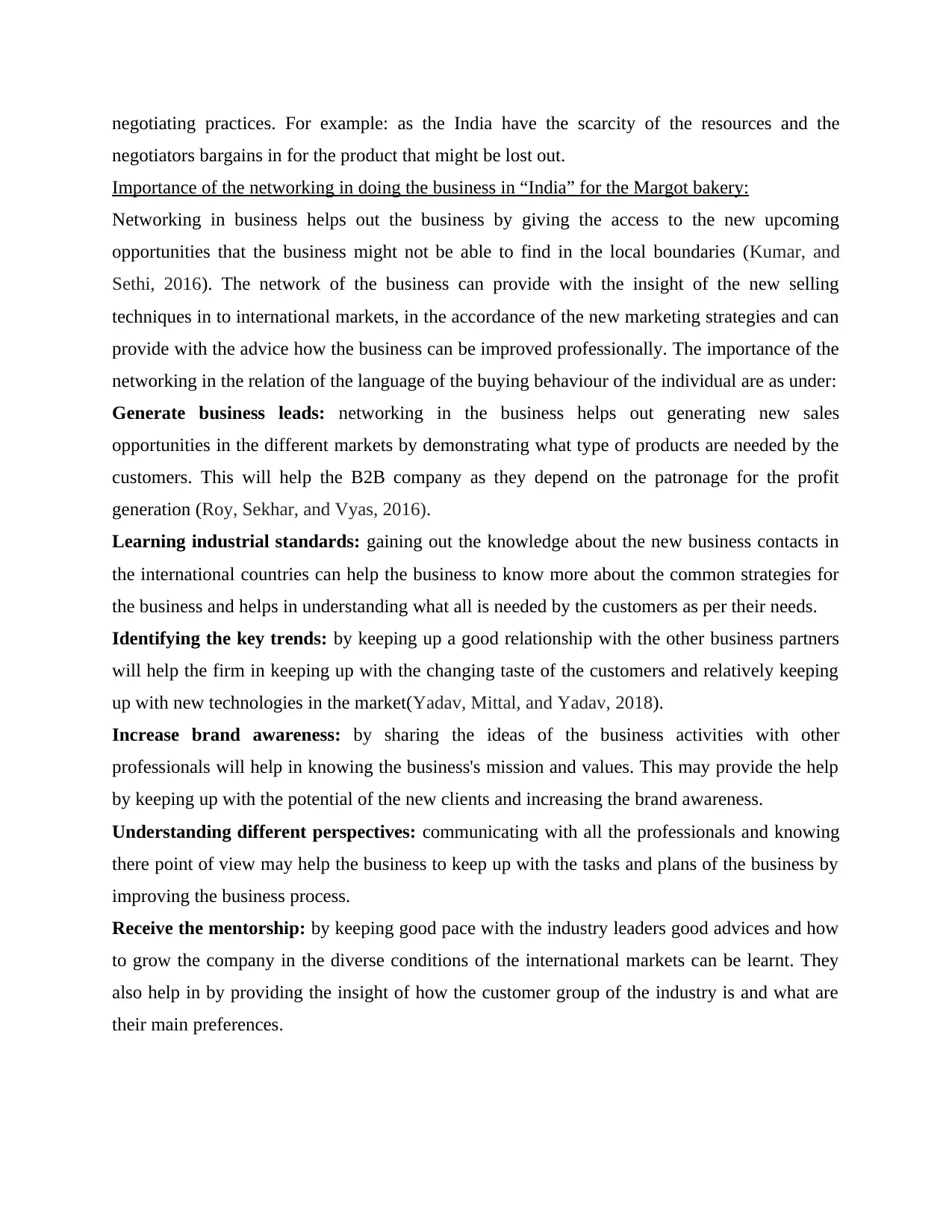
negotiating practices. For example: as the India have the scarcity of the resources and the
negotiators bargains in for the product that might be lost out.
Importance of the networking in doing the business in “India” for the Margot bakery:
Networking in business helps out the business by giving the access to the new upcoming
opportunities that the business might not be able to find in the local boundaries (Kumar, and
Sethi, 2016). The network of the business can provide with the insight of the new selling
techniques in to international markets, in the accordance of the new marketing strategies and can
provide with the advice how the business can be improved professionally. The importance of the
networking in the relation of the language of the buying behaviour of the individual are as under:
Generate business leads: networking in the business helps out generating new sales
opportunities in the different markets by demonstrating what type of products are needed by the
customers. This will help the B2B company as they depend on the patronage for the profit
generation (Roy, Sekhar, and Vyas, 2016).
Learning industrial standards: gaining out the knowledge about the new business contacts in
the international countries can help the business to know more about the common strategies for
the business and helps in understanding what all is needed by the customers as per their needs.
Identifying the key trends: by keeping up a good relationship with the other business partners
will help the firm in keeping up with the changing taste of the customers and relatively keeping
up with new technologies in the market(Yadav, Mittal, and Yadav, 2018).
Increase brand awareness: by sharing the ideas of the business activities with other
professionals will help in knowing the business's mission and values. This may provide the help
by keeping up with the potential of the new clients and increasing the brand awareness.
Understanding different perspectives: communicating with all the professionals and knowing
there point of view may help the business to keep up with the tasks and plans of the business by
improving the business process.
Receive the mentorship: by keeping good pace with the industry leaders good advices and how
to grow the company in the diverse conditions of the international markets can be learnt. They
also help in by providing the insight of how the customer group of the industry is and what are
their main preferences.
negotiators bargains in for the product that might be lost out.
Importance of the networking in doing the business in “India” for the Margot bakery:
Networking in business helps out the business by giving the access to the new upcoming
opportunities that the business might not be able to find in the local boundaries (Kumar, and
Sethi, 2016). The network of the business can provide with the insight of the new selling
techniques in to international markets, in the accordance of the new marketing strategies and can
provide with the advice how the business can be improved professionally. The importance of the
networking in the relation of the language of the buying behaviour of the individual are as under:
Generate business leads: networking in the business helps out generating new sales
opportunities in the different markets by demonstrating what type of products are needed by the
customers. This will help the B2B company as they depend on the patronage for the profit
generation (Roy, Sekhar, and Vyas, 2016).
Learning industrial standards: gaining out the knowledge about the new business contacts in
the international countries can help the business to know more about the common strategies for
the business and helps in understanding what all is needed by the customers as per their needs.
Identifying the key trends: by keeping up a good relationship with the other business partners
will help the firm in keeping up with the changing taste of the customers and relatively keeping
up with new technologies in the market(Yadav, Mittal, and Yadav, 2018).
Increase brand awareness: by sharing the ideas of the business activities with other
professionals will help in knowing the business's mission and values. This may provide the help
by keeping up with the potential of the new clients and increasing the brand awareness.
Understanding different perspectives: communicating with all the professionals and knowing
there point of view may help the business to keep up with the tasks and plans of the business by
improving the business process.
Receive the mentorship: by keeping good pace with the industry leaders good advices and how
to grow the company in the diverse conditions of the international markets can be learnt. They
also help in by providing the insight of how the customer group of the industry is and what are
their main preferences.
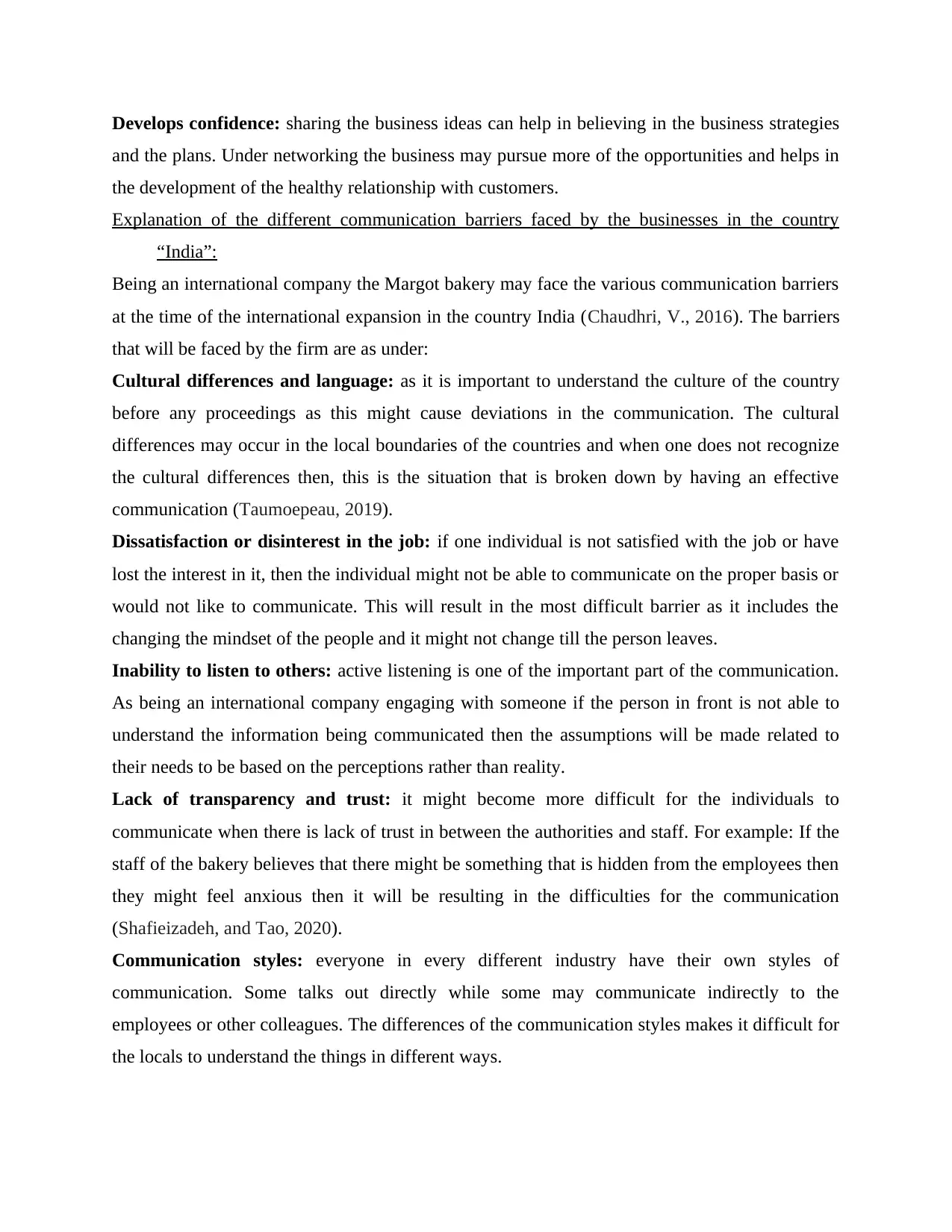
Develops confidence: sharing the business ideas can help in believing in the business strategies
and the plans. Under networking the business may pursue more of the opportunities and helps in
the development of the healthy relationship with customers.
Explanation of the different communication barriers faced by the businesses in the country
“India”:
Being an international company the Margot bakery may face the various communication barriers
at the time of the international expansion in the country India (Chaudhri, V., 2016). The barriers
that will be faced by the firm are as under:
Cultural differences and language: as it is important to understand the culture of the country
before any proceedings as this might cause deviations in the communication. The cultural
differences may occur in the local boundaries of the countries and when one does not recognize
the cultural differences then, this is the situation that is broken down by having an effective
communication (Taumoepeau, 2019).
Dissatisfaction or disinterest in the job: if one individual is not satisfied with the job or have
lost the interest in it, then the individual might not be able to communicate on the proper basis or
would not like to communicate. This will result in the most difficult barrier as it includes the
changing the mindset of the people and it might not change till the person leaves.
Inability to listen to others: active listening is one of the important part of the communication.
As being an international company engaging with someone if the person in front is not able to
understand the information being communicated then the assumptions will be made related to
their needs to be based on the perceptions rather than reality.
Lack of transparency and trust: it might become more difficult for the individuals to
communicate when there is lack of trust in between the authorities and staff. For example: If the
staff of the bakery believes that there might be something that is hidden from the employees then
they might feel anxious then it will be resulting in the difficulties for the communication
(Shafieizadeh, and Tao, 2020).
Communication styles: everyone in every different industry have their own styles of
communication. Some talks out directly while some may communicate indirectly to the
employees or other colleagues. The differences of the communication styles makes it difficult for
the locals to understand the things in different ways.
and the plans. Under networking the business may pursue more of the opportunities and helps in
the development of the healthy relationship with customers.
Explanation of the different communication barriers faced by the businesses in the country
“India”:
Being an international company the Margot bakery may face the various communication barriers
at the time of the international expansion in the country India (Chaudhri, V., 2016). The barriers
that will be faced by the firm are as under:
Cultural differences and language: as it is important to understand the culture of the country
before any proceedings as this might cause deviations in the communication. The cultural
differences may occur in the local boundaries of the countries and when one does not recognize
the cultural differences then, this is the situation that is broken down by having an effective
communication (Taumoepeau, 2019).
Dissatisfaction or disinterest in the job: if one individual is not satisfied with the job or have
lost the interest in it, then the individual might not be able to communicate on the proper basis or
would not like to communicate. This will result in the most difficult barrier as it includes the
changing the mindset of the people and it might not change till the person leaves.
Inability to listen to others: active listening is one of the important part of the communication.
As being an international company engaging with someone if the person in front is not able to
understand the information being communicated then the assumptions will be made related to
their needs to be based on the perceptions rather than reality.
Lack of transparency and trust: it might become more difficult for the individuals to
communicate when there is lack of trust in between the authorities and staff. For example: If the
staff of the bakery believes that there might be something that is hidden from the employees then
they might feel anxious then it will be resulting in the difficulties for the communication
(Shafieizadeh, and Tao, 2020).
Communication styles: everyone in every different industry have their own styles of
communication. Some talks out directly while some may communicate indirectly to the
employees or other colleagues. The differences of the communication styles makes it difficult for
the locals to understand the things in different ways.
Paraphrase This Document
Need a fresh take? Get an instant paraphrase of this document with our AI Paraphraser
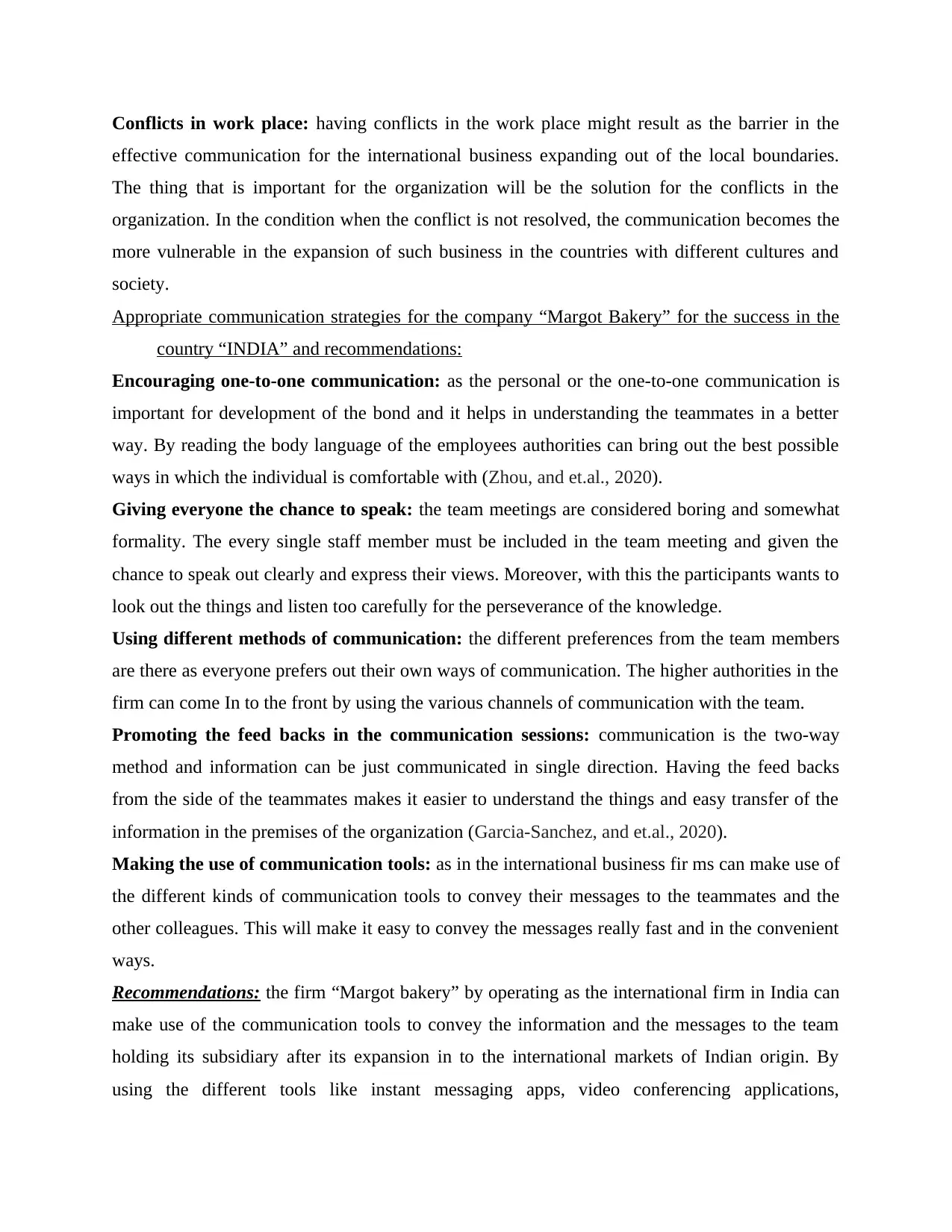
Conflicts in work place: having conflicts in the work place might result as the barrier in the
effective communication for the international business expanding out of the local boundaries.
The thing that is important for the organization will be the solution for the conflicts in the
organization. In the condition when the conflict is not resolved, the communication becomes the
more vulnerable in the expansion of such business in the countries with different cultures and
society.
Appropriate communication strategies for the company “Margot Bakery” for the success in the
country “INDIA” and recommendations:
Encouraging one-to-one communication: as the personal or the one-to-one communication is
important for development of the bond and it helps in understanding the teammates in a better
way. By reading the body language of the employees authorities can bring out the best possible
ways in which the individual is comfortable with (Zhou, and et.al., 2020).
Giving everyone the chance to speak: the team meetings are considered boring and somewhat
formality. The every single staff member must be included in the team meeting and given the
chance to speak out clearly and express their views. Moreover, with this the participants wants to
look out the things and listen too carefully for the perseverance of the knowledge.
Using different methods of communication: the different preferences from the team members
are there as everyone prefers out their own ways of communication. The higher authorities in the
firm can come In to the front by using the various channels of communication with the team.
Promoting the feed backs in the communication sessions: communication is the two-way
method and information can be just communicated in single direction. Having the feed backs
from the side of the teammates makes it easier to understand the things and easy transfer of the
information in the premises of the organization (Garcia-Sanchez, and et.al., 2020).
Making the use of communication tools: as in the international business fir ms can make use of
the different kinds of communication tools to convey their messages to the teammates and the
other colleagues. This will make it easy to convey the messages really fast and in the convenient
ways.
Recommendations: the firm “Margot bakery” by operating as the international firm in India can
make use of the communication tools to convey the information and the messages to the team
holding its subsidiary after its expansion in to the international markets of Indian origin. By
using the different tools like instant messaging apps, video conferencing applications,
effective communication for the international business expanding out of the local boundaries.
The thing that is important for the organization will be the solution for the conflicts in the
organization. In the condition when the conflict is not resolved, the communication becomes the
more vulnerable in the expansion of such business in the countries with different cultures and
society.
Appropriate communication strategies for the company “Margot Bakery” for the success in the
country “INDIA” and recommendations:
Encouraging one-to-one communication: as the personal or the one-to-one communication is
important for development of the bond and it helps in understanding the teammates in a better
way. By reading the body language of the employees authorities can bring out the best possible
ways in which the individual is comfortable with (Zhou, and et.al., 2020).
Giving everyone the chance to speak: the team meetings are considered boring and somewhat
formality. The every single staff member must be included in the team meeting and given the
chance to speak out clearly and express their views. Moreover, with this the participants wants to
look out the things and listen too carefully for the perseverance of the knowledge.
Using different methods of communication: the different preferences from the team members
are there as everyone prefers out their own ways of communication. The higher authorities in the
firm can come In to the front by using the various channels of communication with the team.
Promoting the feed backs in the communication sessions: communication is the two-way
method and information can be just communicated in single direction. Having the feed backs
from the side of the teammates makes it easier to understand the things and easy transfer of the
information in the premises of the organization (Garcia-Sanchez, and et.al., 2020).
Making the use of communication tools: as in the international business fir ms can make use of
the different kinds of communication tools to convey their messages to the teammates and the
other colleagues. This will make it easy to convey the messages really fast and in the convenient
ways.
Recommendations: the firm “Margot bakery” by operating as the international firm in India can
make use of the communication tools to convey the information and the messages to the team
holding its subsidiary after its expansion in to the international markets of Indian origin. By
using the different tools like instant messaging apps, video conferencing applications,
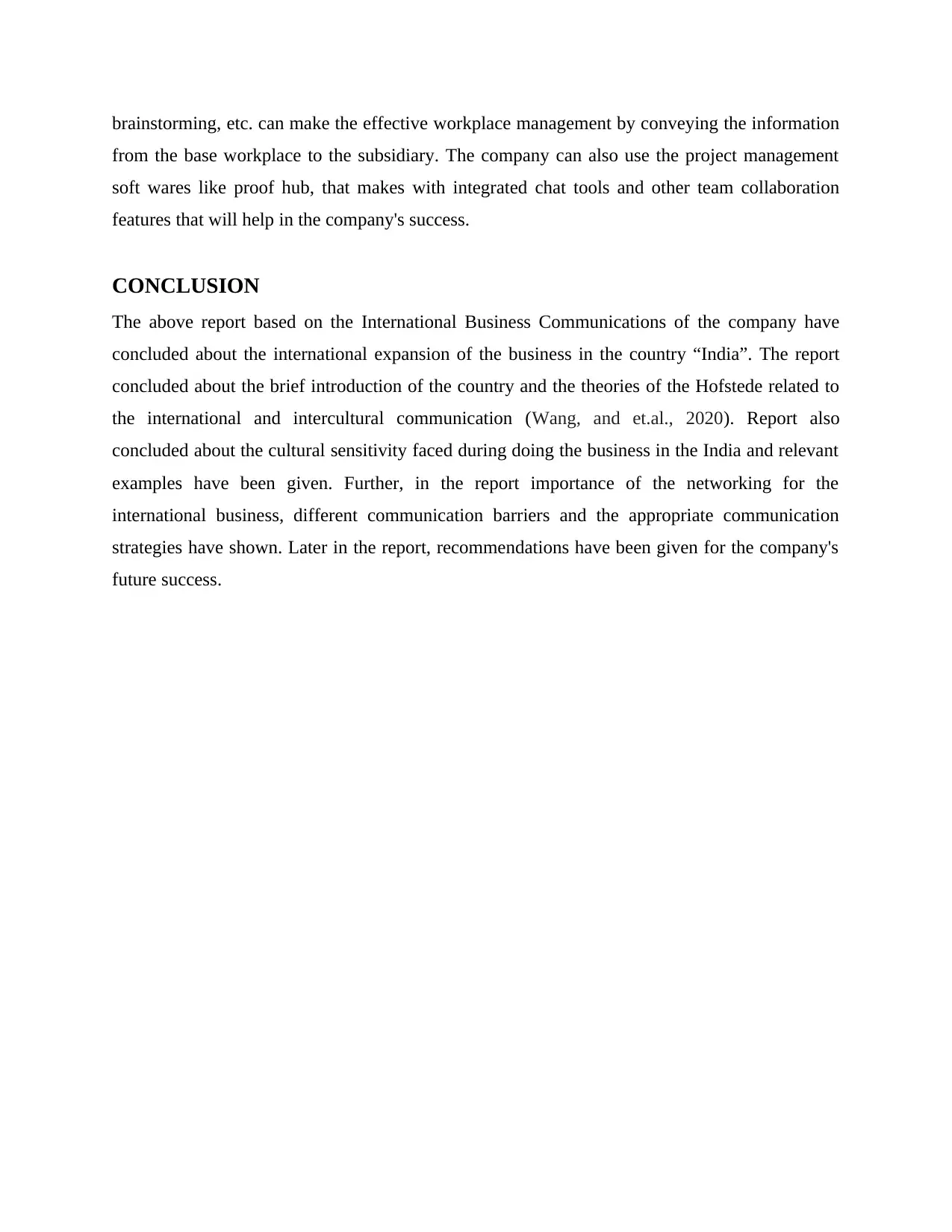
brainstorming, etc. can make the effective workplace management by conveying the information
from the base workplace to the subsidiary. The company can also use the project management
soft wares like proof hub, that makes with integrated chat tools and other team collaboration
features that will help in the company's success.
CONCLUSION
The above report based on the International Business Communications of the company have
concluded about the international expansion of the business in the country “India”. The report
concluded about the brief introduction of the country and the theories of the Hofstede related to
the international and intercultural communication (Wang, and et.al., 2020). Report also
concluded about the cultural sensitivity faced during doing the business in the India and relevant
examples have been given. Further, in the report importance of the networking for the
international business, different communication barriers and the appropriate communication
strategies have shown. Later in the report, recommendations have been given for the company's
future success.
from the base workplace to the subsidiary. The company can also use the project management
soft wares like proof hub, that makes with integrated chat tools and other team collaboration
features that will help in the company's success.
CONCLUSION
The above report based on the International Business Communications of the company have
concluded about the international expansion of the business in the country “India”. The report
concluded about the brief introduction of the country and the theories of the Hofstede related to
the international and intercultural communication (Wang, and et.al., 2020). Report also
concluded about the cultural sensitivity faced during doing the business in the India and relevant
examples have been given. Further, in the report importance of the networking for the
international business, different communication barriers and the appropriate communication
strategies have shown. Later in the report, recommendations have been given for the company's
future success.
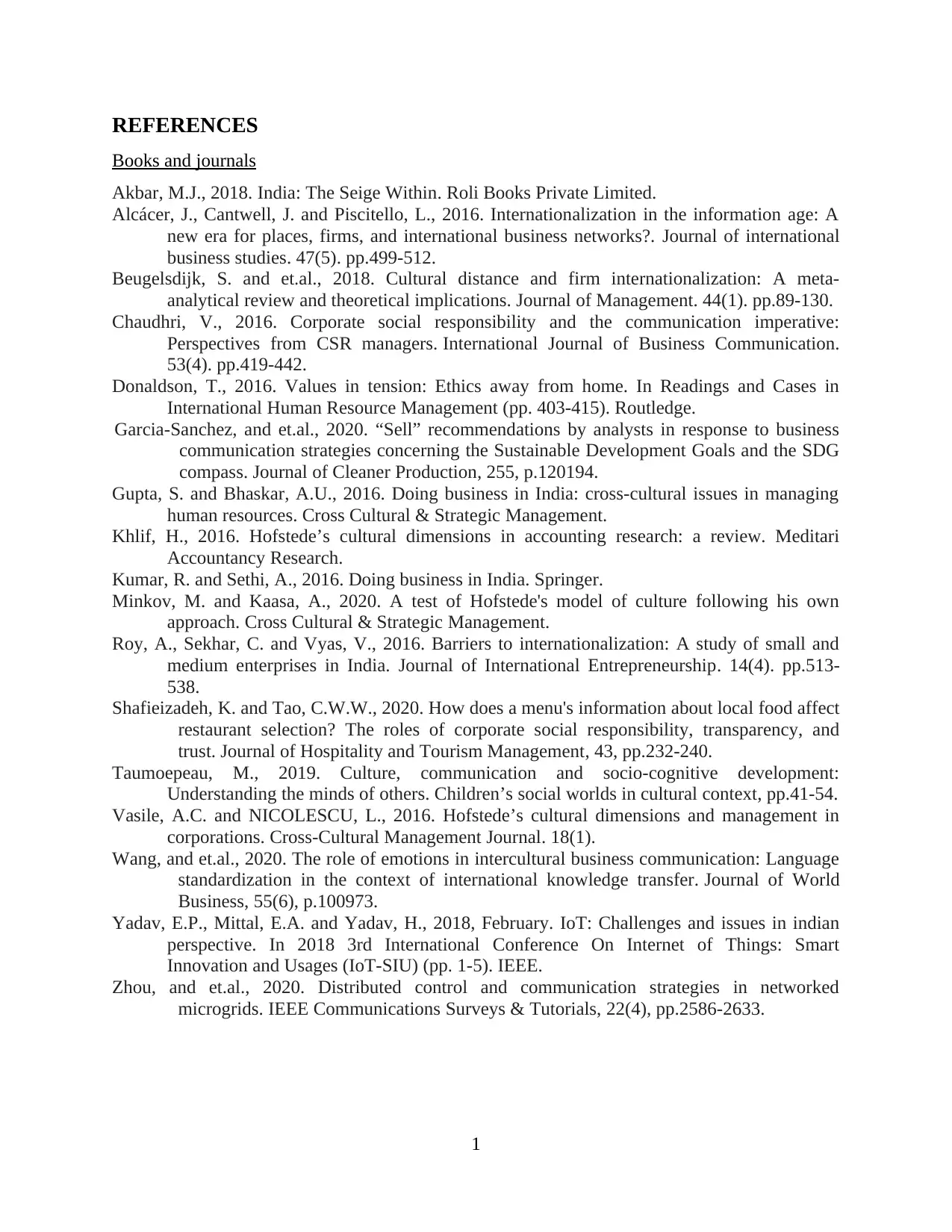
REFERENCES
Books and journals
Akbar, M.J., 2018. India: The Seige Within. Roli Books Private Limited.
Alcácer, J., Cantwell, J. and Piscitello, L., 2016. Internationalization in the information age: A
new era for places, firms, and international business networks?. Journal of international
business studies. 47(5). pp.499-512.
Beugelsdijk, S. and et.al., 2018. Cultural distance and firm internationalization: A meta-
analytical review and theoretical implications. Journal of Management. 44(1). pp.89-130.
Chaudhri, V., 2016. Corporate social responsibility and the communication imperative:
Perspectives from CSR managers. International Journal of Business Communication.
53(4). pp.419-442.
Donaldson, T., 2016. Values in tension: Ethics away from home. In Readings and Cases in
International Human Resource Management (pp. 403-415). Routledge.
Garcia-Sanchez, and et.al., 2020. “Sell” recommendations by analysts in response to business
communication strategies concerning the Sustainable Development Goals and the SDG
compass. Journal of Cleaner Production, 255, p.120194.
Gupta, S. and Bhaskar, A.U., 2016. Doing business in India: cross-cultural issues in managing
human resources. Cross Cultural & Strategic Management.
Khlif, H., 2016. Hofstede’s cultural dimensions in accounting research: a review. Meditari
Accountancy Research.
Kumar, R. and Sethi, A., 2016. Doing business in India. Springer.
Minkov, M. and Kaasa, A., 2020. A test of Hofstede's model of culture following his own
approach. Cross Cultural & Strategic Management.
Roy, A., Sekhar, C. and Vyas, V., 2016. Barriers to internationalization: A study of small and
medium enterprises in India. Journal of International Entrepreneurship. 14(4). pp.513-
538.
Shafieizadeh, K. and Tao, C.W.W., 2020. How does a menu's information about local food affect
restaurant selection? The roles of corporate social responsibility, transparency, and
trust. Journal of Hospitality and Tourism Management, 43, pp.232-240.
Taumoepeau, M., 2019. Culture, communication and socio-cognitive development:
Understanding the minds of others. Children’s social worlds in cultural context, pp.41-54.
Vasile, A.C. and NICOLESCU, L., 2016. Hofstede’s cultural dimensions and management in
corporations. Cross-Cultural Management Journal. 18(1).
Wang, and et.al., 2020. The role of emotions in intercultural business communication: Language
standardization in the context of international knowledge transfer. Journal of World
Business, 55(6), p.100973.
Yadav, E.P., Mittal, E.A. and Yadav, H., 2018, February. IoT: Challenges and issues in indian
perspective. In 2018 3rd International Conference On Internet of Things: Smart
Innovation and Usages (IoT-SIU) (pp. 1-5). IEEE.
Zhou, and et.al., 2020. Distributed control and communication strategies in networked
microgrids. IEEE Communications Surveys & Tutorials, 22(4), pp.2586-2633.
1
Books and journals
Akbar, M.J., 2018. India: The Seige Within. Roli Books Private Limited.
Alcácer, J., Cantwell, J. and Piscitello, L., 2016. Internationalization in the information age: A
new era for places, firms, and international business networks?. Journal of international
business studies. 47(5). pp.499-512.
Beugelsdijk, S. and et.al., 2018. Cultural distance and firm internationalization: A meta-
analytical review and theoretical implications. Journal of Management. 44(1). pp.89-130.
Chaudhri, V., 2016. Corporate social responsibility and the communication imperative:
Perspectives from CSR managers. International Journal of Business Communication.
53(4). pp.419-442.
Donaldson, T., 2016. Values in tension: Ethics away from home. In Readings and Cases in
International Human Resource Management (pp. 403-415). Routledge.
Garcia-Sanchez, and et.al., 2020. “Sell” recommendations by analysts in response to business
communication strategies concerning the Sustainable Development Goals and the SDG
compass. Journal of Cleaner Production, 255, p.120194.
Gupta, S. and Bhaskar, A.U., 2016. Doing business in India: cross-cultural issues in managing
human resources. Cross Cultural & Strategic Management.
Khlif, H., 2016. Hofstede’s cultural dimensions in accounting research: a review. Meditari
Accountancy Research.
Kumar, R. and Sethi, A., 2016. Doing business in India. Springer.
Minkov, M. and Kaasa, A., 2020. A test of Hofstede's model of culture following his own
approach. Cross Cultural & Strategic Management.
Roy, A., Sekhar, C. and Vyas, V., 2016. Barriers to internationalization: A study of small and
medium enterprises in India. Journal of International Entrepreneurship. 14(4). pp.513-
538.
Shafieizadeh, K. and Tao, C.W.W., 2020. How does a menu's information about local food affect
restaurant selection? The roles of corporate social responsibility, transparency, and
trust. Journal of Hospitality and Tourism Management, 43, pp.232-240.
Taumoepeau, M., 2019. Culture, communication and socio-cognitive development:
Understanding the minds of others. Children’s social worlds in cultural context, pp.41-54.
Vasile, A.C. and NICOLESCU, L., 2016. Hofstede’s cultural dimensions and management in
corporations. Cross-Cultural Management Journal. 18(1).
Wang, and et.al., 2020. The role of emotions in intercultural business communication: Language
standardization in the context of international knowledge transfer. Journal of World
Business, 55(6), p.100973.
Yadav, E.P., Mittal, E.A. and Yadav, H., 2018, February. IoT: Challenges and issues in indian
perspective. In 2018 3rd International Conference On Internet of Things: Smart
Innovation and Usages (IoT-SIU) (pp. 1-5). IEEE.
Zhou, and et.al., 2020. Distributed control and communication strategies in networked
microgrids. IEEE Communications Surveys & Tutorials, 22(4), pp.2586-2633.
1
Secure Best Marks with AI Grader
Need help grading? Try our AI Grader for instant feedback on your assignments.

2
1 out of 11
Related Documents
Your All-in-One AI-Powered Toolkit for Academic Success.
+13062052269
info@desklib.com
Available 24*7 on WhatsApp / Email
![[object Object]](/_next/static/media/star-bottom.7253800d.svg)
Unlock your academic potential
© 2024 | Zucol Services PVT LTD | All rights reserved.



